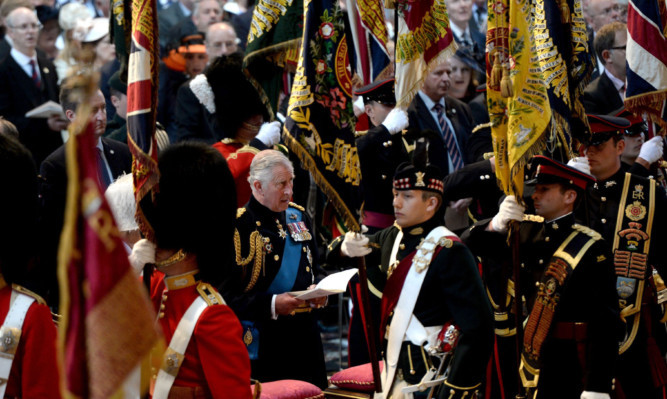The Prince of Wales and the Prime Minister have attended a memorial service for the 200th anniversary of the Battle of Waterloo – a victory which finally toppled Napoleon.
Trumpeters of the Household Cavalry announced the arrival of Charles with the Duchess of Cornwall for the service at St Paul’s Cathedral in London.
British soldiers in full military regalia, some wearing plumes in their hats, stood to attention outside the cathedral next to old military guns as the guests went in.
The Earl of Wessex, the Duke and Duchess of Gloucester, Boris Johnson and descendants of those who fought in the bloody battle, including the 9th Duke of Wellington, were among those at the service.
Guests filed in to remember the day, 200 years ago, when nearly 180,000 men from across Europe converged on the muddy battlefield at Waterloo in modern day Belgium.
Squadron Sergeant Major Tony Gray, 76, of the Light Cavalry, proudly wore three medals, including the Queen’s Medal for distinguished service, pinned to his uniform.
He said: “This anniversary means a great deal. The battle changed history. Had we not won, we probably would be speaking French now.”
On June 18 1815, Napoleon’s formidable Grande Armee clashed with Allied troops, led by the British military commander, the Duke of Wellington.
The French leader and former emperor had returned from exile that year and, in what he hoped would be a decisive blow, attacked allied troops which had massed on the border.
But in what the Duke of Wellington described as “the nearest-run thing you ever saw in your life”, the Allied army of British, Dutch and Prussian troops defeated Napoleon’s forces.
The Prince wore his Field Marshall frock coat, Knight of the Garter Star, Knight of the Thistle Star, Order of the Bath (neck order) and Order of Merit for the service.
Camilla wore a white coat, designed by Anna Valentine, with a beige feathered hat and matching shoes.
Stirring extracts from accounts of the battle – the “clashing of swords, the clattering of musketry, the hissing of balls” – were read by British, French and German readers.
Lieutenant Achilles Barron of The Rifles read an extract from Major George Simmons of the 95th Rifles, who recounts struggling with the “thick clayey mud” and rain which lashed down on the eve of the battle.
Lt Barron said: “Bad weather is something any soldier can relate to, I feel sympathetic to the men who were there – before the battle has even begun. It is a massive honour to be chosen to give the reading.”
He warned the battle risks “fading” from people’s memories, and it is important the Napoleonic Wars are remembered.
The church bells rang after the ceremony as members of the Royal Family walked out to be greeted by schoolgirls Lucy King and Isabella Marter.
Lucy, who turns 13 today and is from Suffolk, gave a posy of flowers to Camilla.
And Isabella, 12, from Stoke Newington in north London, gave hers to the Duchess of Gloucester.
Isabella was picked to give the flowers because one of her ancestors, Major Arthur Rowley Heyland, died at the battle.
He wrote a moving letter to his wife Mary on the eve of the fight, and she carried the letter with her every day of her life until she died in 1858 when she was buried with it in her grave.
Isabella said: “It was really exciting giving the flowers to the Duchess.
“I’ve read the letter, it’s really beautiful, you can tell he was a really loving man.”
